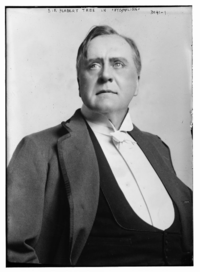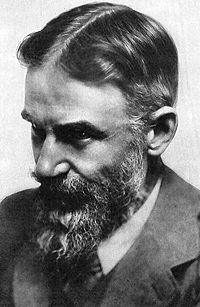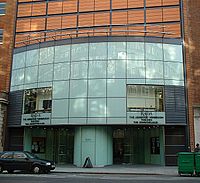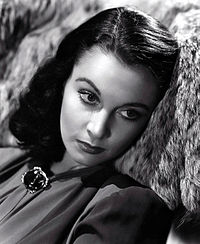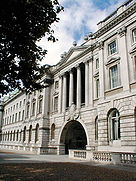- Royal Academy of Dramatic Art
-
"RADA" redirects here. For the company, see RADA Electronic Industries.
Royal Academy of Dramatic Art Established 1904 Type Drama school Director Edward Kemp Location London, United Kingdom Affiliations Conservatoire for Dance and Drama
King's College London
National Council for Drama TrainingWebsite http://www.rada.ac.uk/ The Royal Academy of Dramatic Art (RADA) is a drama school located in London, United Kingdom. It is generally regarded as one of the most renowned drama schools in the world, and is one of the oldest drama schools in the United Kingdom, having been founded in 1904.[1]
RADA is an affiliate school of the Conservatoire for Dance and Drama and its higher education awards are validated by King's College London.[2] It is based in the Bloomsbury area of Central London, close to the Senate House complex of the University of London.[3]
The current Director of the Academy is Edward Kemp.[4] The President is Lord Attenborough, the Chairman is Sir Stephen Waley-Cohen and the Vice-Chairman is Alan Rickman.[5]
Contents
History
20th century
In 1904 Herbert Beerbohm Tree established an Academy of Dramatic Art at His Majesty's Theatre in the Haymarket (London).[6] In 1905 the Academy moved to 62 Gower Street. Fees of six guineas a term were doubled in 1906, except for the children of actors, who paid only half[clarification needed]. A managing council was established on which Tree was joined, among others, by Sir Johnston Forbes-Robertson, Sir Arthur Wing Pinero and Sir James Barrie. Within a few years they were augmented by others, including W. S. Gilbert, Irene Vanbrugh and George Bernard Shaw. In 1909 Kenneth Barnes, brother of the Vanbrugh sisters, was appointed principal. In 1912 George Bernard Shaw donated the royalties from Pygmalion to RADA; the Academy ultimately benefitted substantially from the success of My Fair Lady. Pre-First World War graduates of the Academy included Athene Seyler, who became president in 1950, Robert Atkins and Cedric Hardwicke. During this period Beerbohm Tree took some forty academy graduates into his company at His Majesty's.
In 1920 the Academy was granted its Royal Charter. In 1921 a new theatre for the academy was built in Malet Street, adjacent to the Gower Street premises. In 1923 John Gielgud, who would later become President and first Honorary Fellow of RADA, studied at the Academy for a year. In 1924 the Academy received its first government subsidy in the form of a Treasury grant of £500. In 1927 the two Georgian houses which comprised the Gower Street site were replaced with a single new building, with George Bernard Shaw donating £5,000 towards the cost. In 1931 the Duchess of York opened the new building. In 1941 Richard Attenborough joined the Academy as a Leverhulme scholar. At the height of World War II, the Academy's theatre was demolished during an air-raid and public performances moved to the City Literary Institute. Academy students toured shows to the troops. The sculptor Alan Durst was responsible for the sculptural work over the Malet Street entrance.[citation needed]
In 1950 George Bernard Shaw died and bequeathed one third of all his royalties to RADA. In 1954 the new Vanbrugh Theatre, named after Irene Vanbrugh, was opened by Her Majesty Queen Elizabeth The Queen Mother. In 1955 Sir Kenneth Barnes retired and John Fernald was appointed principal. The number of students was reduced and entry became more difficult. During the late 1950s and 1960s the growth of the LEA grant systems ushered in a 'new wave' of actors including Albert Finney, Tom Courtenay, Glenda Jackson, John Hurt, Michael Williams and Anthony Hopkins. In 1962 a stage management course was introduced. In 1964 the Vanbrugh Theatre Club was established. In 1967, following debate concerning RADA receiving funds from the Shaw bequest, the Government withdrew its annual grant. In 1970 specialist technical courses were established. In 1977 the 'Tree ' evenings, named in honour of RADA's founder, were introduced with leading agents and casting directors invited to presentations by final year students in the Vanbrugh. During this period another 'new wave' of actors emerges at the Academy, including Jonathan Pryce, Juliet Stevenson, Alan Rickman, Anton Lesser, Kenneth Branagh, Bruce Payne and Fiona Shaw.
In 1986 the acting diploma course was extended from seven to nine terms. In 1989 HRH, The Princess of Wales, visited the Academy as President of Council to install her predecessor, Sir John Gielgud, as RADA's first Honorary Fellow. In 1990 the Academy invested the capital accrued from the Shaw bequest in the freehold of 18 Chenies Street, with the help of donations from the Foundation for Sport and the Arts and British Telecommunications. King's College London offered an MA in text and performance study in conjunction with the Academy. In 1993 the 'Friends of RADA' was inaugurated and the academy established its first courses for Japanese professional actors in Tokyo. In 1996 RADA received a £22.7m grant from the Arts Council National Lottery Board towards redeveloping the academy's headquarters, including a complete re-build of the Vanbrugh Theatre and Malet Street premises designed by London based architect Bryan Avery of Avery Associates Architects. The council established a committee to raise the necessary matching funds of £8m over four years. Discretionary local authority grants were phased out over the next two years. In 1997 the rebuilding of the Gower/Malet Street premises began. In 1995/8 the Academy extended its portfolio of short courses for British actors and special courses for American and Japanese students in London. In 1998 the Vanbrugh Theatre Club was dissolved. In 2000 Her Majesty Queen Elizabeth II re-opened the academy's refurbished Gower Street/Malet Street building.
21st century
In 2001 the second stage of the Centenary Project, to create new spaces for the Academy's work at 20 and 22 Chenies Street, began. In 2001 RADA became one of the two founding affiliates of Britain's first higher education Conservatoire for Dance and Drama and RADA courses began being validated by King's College London. In 2002 the King's College London awarded the first BA in acting to an academy student and the RADA Youth Group was launched. In 2004 RADA celebrated its centenary. In 2006 the academy replaced the Friends of RADA with a new scheme for supporters, the RADA Stars. In 2007 the Academy introduced its one-year drama foundation course, accepting 32 pupils per year. In 2007 the role of principal was abolished and new roles of 'managing director' and 'artistic director' were established.
Admissions
RADA accepts 28 new students each year into its three year BA in acting course. Admission is based on suitability and successful audition. RADA also teaches Technical Theatre & Stage Management (TTSM) - a two year Foundation Degree in Technical Theatre and Stage Management, with admissions of up to 28 students a year. There are also specialist technical subjects through 4 term graduate certificate courses (in Theatre Design, Theatre Costume, Scenic Art (this course runs in partnership with the apprenticeship schemes of the Royal Opera House and The Royal National Theatre), Scenic Construction, Property Making and Stage Electrics and Lighting Design) and offers a Master (MA) in Text and Performance Studies taught jointly between RADA and Birkbeck College, University of London. Approximately 35 students are chosen each year for these courses.
Associate members
RADA has a number of notable associate members including Jane Asher, Sir Michael Gambon, Robert Bourne, Kenneth Branagh, Jon Cryer, Richard Digby Day, Trevor Eve, Ralph Fiennes, Edward Fox, Iain Glen, Gerald Harper, Sir Ian Holm, Sir Anthony Hopkins, Sir Derek Jacobi, Patricia Kneale, Paul McGann, Dame Helen Mirren, Sir Trevor Nunn, Peter O'Toole, Dame Diana Rigg, Sir Evelyn de Rothschild, Lord Snowdon, Shelley Thompson, Ian Carmichael, Alan Rickman, Timothy Dalton and Sir Roger Moore. Joan Collins OBE serves as the Honorary President of the RADA Associates.
Notable alumni
 John Gielgud, who studied at RADA in 1923 and would eventually become President and first Honorary Fellow.
John Gielgud, who studied at RADA in 1923 and would eventually become President and first Honorary Fellow.
Students at RADA have included:
- Gemma Arterton (born 1986), film, stage and television actress
- Richard Attenborough, Baron Attenborough (born 1923), actor, director and producer
- Sir Alan Bates (1934–2003), film, stage and television actor
- Kenneth Branagh (born 1960), actor and film director
- Joan Collins (born 1933), actress and producer
- Timothy Dalton (born 1946), film, stage and television actor
- Denholm Elliott (1922–1992), film, stage and television actor[7]
- Brian Epstein (1934–1967), music entrepreneur and manager
- Ralph Fiennes (born 1962), film and stage actor
- Albert Finney (born 1936), film, stage and television actor
- Sir Michael Gambon (born 1940), film, stage and television actor
- Sir John Gielgud (1904–2000), actor, director and producer
- Maggie Gyllenhaal (born 1977), stage and screen actress
- Sir Anthony Hopkins (born 1937), film, stage and television actor
- John Hurt (born 1940), actor and vocal artist
- Indira Varma (born 1973), stage and screen actress
- Glenda Jackson (born 1936), actress and Labour MP
- Sir Derek Jacobi (born 1938), actor and director
- Charles Laughton (1899–1962), actor, screenwriter and producer
- Vivien Leigh (1913–1967), stage and screen actress
- Sir Roger Moore (born 1927), actor and film producer
- Joe Orton (1933-1967), playwright
- Peter O'Toole (born 1932), stage and screen actor
- Clive Owen (born 1964), film actor
- Harold Pinter (1930–2008), playwright, director and screenwriter
- Jonathan Pryce (born 1947), actor and singer
- Alan Rickman (born 1946), actor and theatre director
- Dame Diana Rigg (born 1938), stage and film actress
- Michael Sheen (born 1969), stage and film actor
- Erika Slezak (born 1946), stage and television actress
- Susannah York (1939–2011), film, stage and television actress
References
- ^ RADA Britannica.com.
- ^ "RADA: An introduction". Royal Academy of Dramatic Art. http://www.rada.ac.uk/about-rada/rada-introduction. Retrieved 9 November 2010.
- ^ "Visiting us". Royal Academy of Dramatic Art. http://www.rada.ac.uk/about-rada/visiting-us. Retrieved 9 November 2010.
- ^ "RADA staff". Royal Academy of Dramatic Art. http://www.rada.ac.uk/about-rada/rada-staff. Retrieved 9 November 2010.
- ^ "Governance and advisers". Royal Academy of Dramatic Art. http://www.rada.ac.uk/about-rada/governance. Retrieved 9 November 2010.
- ^ RADA Conservatoire for Dance and Drama.
- ^ "British Film Institute biography". http://www.screenonline.org.uk/people/id/452513/index.html. Retrieved 2007-09-24.
External links
Conservatoire for Dance and Drama Bristol Old Vic Theatre School · Central School of Ballet · The Circus Space · London Academy of Music and Dramatic Art · London Contemporary Dance School · Northern School of Contemporary Dance · Rambert School of Ballet and Contemporary Dance · Royal Academy of Dramatic Art · Royal Scottish Academy of Music and Drama Performing arts schools in the United Kingdom
Performing arts schools in the United KingdomActing Academy of Live and Recorded Arts · Arts Educational Schools, London · Birmingham School of Acting · Bristol Old Vic Theatre School · Central School of Speech and Drama · Drama Centre London · Drama Studio London · East 15 Acting School · Guildford School of Acting · Guildhall School of Music & Drama · Italia Conti Academy of Theatre Arts · Liverpool Institute for Performing Arts · London Academy of Music and Dramatic Art · The Manchester Metropolitan School of Theatre · Mountview Academy of Theatre Arts · Oxford School of Drama · Rose Bruford College · Royal Academy of Dramatic Art · Royal Conservatoire of Scotland · Royal Welsh College of Music & Drama · Stella Mann College of Performing Arts · Tring Park School for the Performing Arts

Dance Bird College · Central School of Ballet · Elmhurst School for Dance · English National Ballet School · The Hammond School · Laine Theatre Arts · Laban · London Contemporary Dance School · London Studio Centre · Masters Performing Arts College · Northern Ballet School · Northern School of Contemporary Dance · Performers College · Royal Ballet School · Scottish School of Contemporary Dance · Stella Mann College of Performing Arts · Tring Park School for the Performing Arts
Music See: Music Schools in the United Kingdom
Musical theatre Arts Educational Schools, London · Bird College · Cambridge Performing Arts · Guildford School of Acting · The Hammond School · Italia Conti Academy of Theatre Arts · Laine Theatre Arts · Leicester Performing Arts · Liverpool Theatre School and College · Masters Performing Arts College · Mountview Academy of Theatre Arts · Performers College · SLP College · Stella Mann College of Performing Arts · Tring Park School for the Performing Arts · The Urdang Academy
Secondary Arts Educational Schools, London · BRIT School · The Hammond School · Italia Conti Academy of Theatre Arts · Sylvia Young Theatre School · Tring Park School for the Performing Arts
Former Bush Davies School of Theatre Arts
Categories:- Education in Camden
- Educational institutions established in 1904
- King's College London
- Performing arts education in London
- Royal Academy of Dramatic Art
- Drama schools in the United Kingdom
- 1904 establishments in England
Wikimedia Foundation. 2010.

